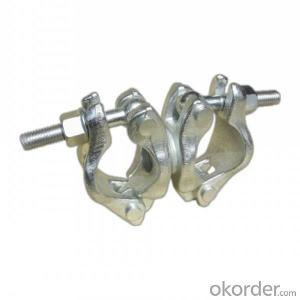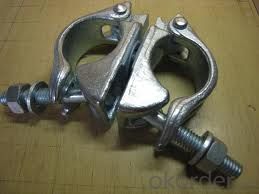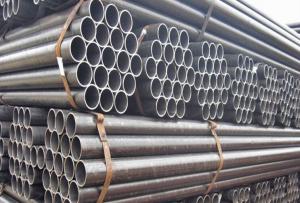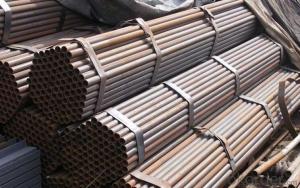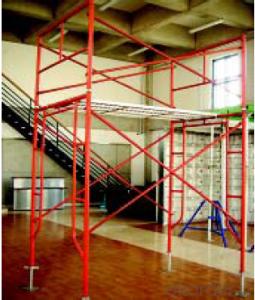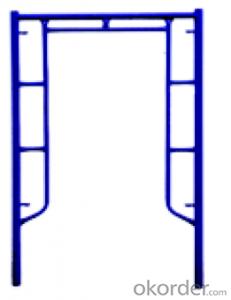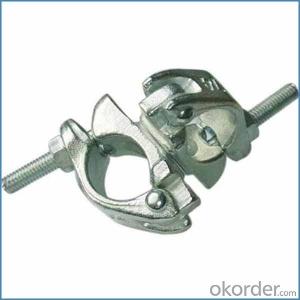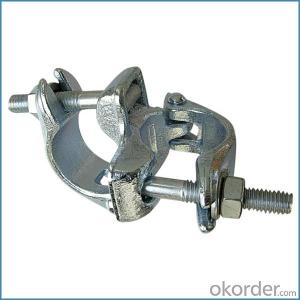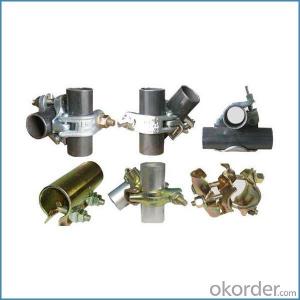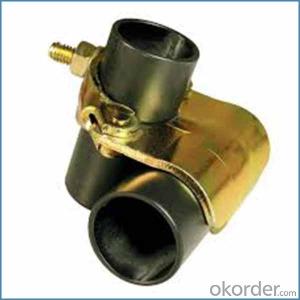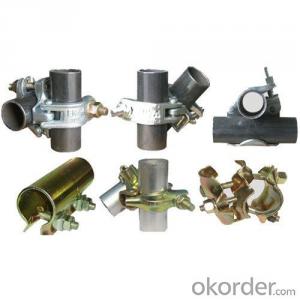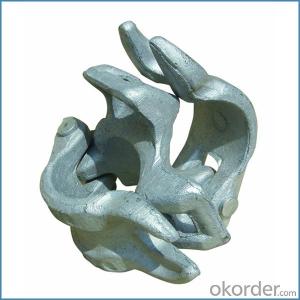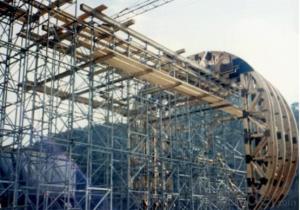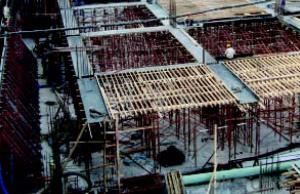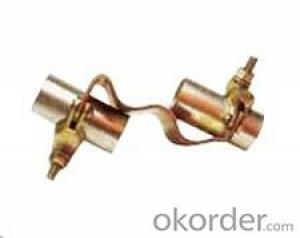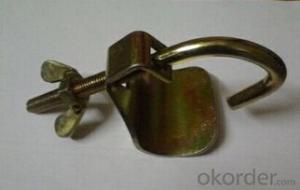Scaffolding Joint Clamp british German Forged Type
- Loading Port:
- Tianjin
- Payment Terms:
- TT OR LC
- Min Order Qty:
- 1000 kg
- Supply Capability:
- 100000 kg/month
OKorder Service Pledge
OKorder Financial Service
You Might Also Like
Scaffolding Joint Clamp british German Forged Type
Description
1.The scaffolding coupler is always used to connect the steel pipe as scaffolding system.
2.The often used coupler is swivel coupler and righ angle coupler .
3.We can provide types of scaffolding coupler according to your requirement.
4.Couoler can fix the 48.3mm scaffolding steel pipe tightly and make the whole scaffolding system more steadily.
Feature
(1)Excellent Anti-Breaking—Cold Pressed Steel
(2)Outstanding Resistance Deformation
(3)Strong Anti-Dropping Ability
Photo
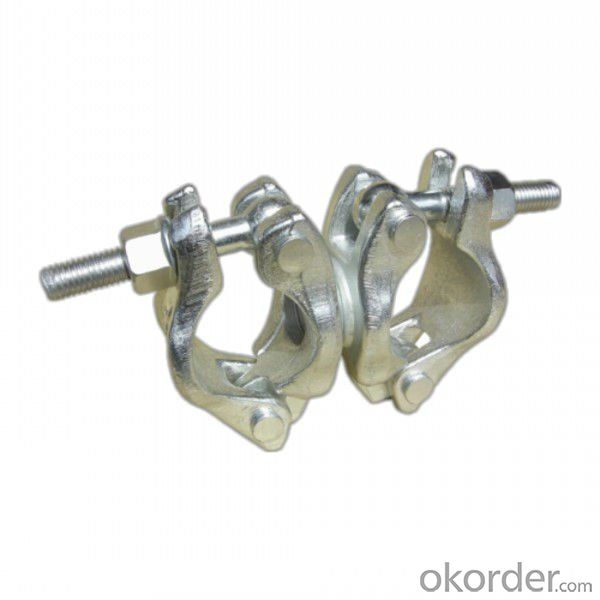
Parameter
| Material | Q235,345steel |
| Size | 48.3mm*48.3mm |
| Surface finish | Galvanized |
| Weight | 1.1kg around |
| Standard | BS1139,EN74 |
| Package | 25pcs/bag,steel pallet |
| Manufacture | As per customer requirement |
| Market | Africa, South America, the Middle East and Asia |
FAQ
Q: Are you a factory or trading company?
We are a state-owned corporation in China,dealing with various kinds of building materials.We have our holding subsidiaries.
Q: Where is your factory located? How can I visit there?
Our factory is located all around China.
Q: Can I get some samples?
Sample is free, customer only pay freight for the first time.
Q: Delivery?
10-30days. (5-15 containers)
Any question,feel free to contact us.
- Q: Are steel tube couplers resistant to corrosion and rust?
- Yes, steel tube couplers are resistant to corrosion and rust. Steel is known for its durability and strength, making it a popular material choice for various applications. Steel tube couplers are typically made from galvanized or stainless steel, both of which have excellent corrosion resistance properties. Galvanized steel is coated with a protective layer of zinc, which acts as a barrier against moisture and prevents the formation of rust. Stainless steel, on the other hand, contains chromium, which forms a passive oxide layer on the surface, protecting it from corrosion. Therefore, steel tube couplers are highly resistant to rust and corrosion, making them suitable for use in various industries and environments, including construction, plumbing, and automotive.
- Q: How are steel tube couplers attached to scaffolding tubes?
- Steel tube couplers are typically attached to scaffolding tubes using a simple and effective method. The process involves sliding the coupler onto the end of the tube and then tightening the bolts or screws on the coupler to secure it in place. The coupler is designed with a split sleeve that grips the tube tightly, ensuring a secure connection. This method allows for easy and quick installation and removal of the coupler without the need for any specialized tools. The attachment of steel tube couplers to scaffolding tubes is crucial as it forms the structural framework of the scaffolding system, providing stability and support for workers and materials on site.
- Q: How does a sleeve coupler work in scaffolding?
- A sleeve coupler is an essential component in scaffolding that is used to connect two scaffold tubes together. It consists of a cylindrical sleeve that fits over the ends of two tubes and is secured in place by tightening bolts or clamps. To use a sleeve coupler, the ends of two scaffold tubes are inserted into the coupler's sleeve, ensuring that they are fully inserted. The bolts or clamps are then tightened to secure the tubes in place, creating a strong and stable connection. The sleeve coupler works by creating a frictional grip between the tubes and the coupler. As the bolts or clamps are tightened, they apply pressure on the tubes, causing them to grip tightly onto the coupler's sleeve. This frictional grip ensures that the tubes remain securely connected, even under the weight and pressure of workers and equipment on the scaffold. The design of the sleeve coupler also allows for easy assembly and disassembly of scaffolding. When it is time to disassemble the scaffold, the bolts or clamps can be loosened, allowing the tubes to be easily removed from the coupler. Overall, a sleeve coupler is a simple yet effective device used in scaffolding to create a secure connection between scaffold tubes, providing stability and safety for workers and ensuring the integrity of the scaffold structure.
- Q: What are the common reasons for failure or malfunction of steel tube couplers?
- There are several common reasons for failure or malfunction of steel tube couplers. One of the primary reasons is improper installation. If the coupler is not properly aligned and tightened, it can lead to misalignment or slippage, causing the joint to fail. It is crucial to follow the manufacturer's guidelines and use the correct tools to ensure a secure and tight connection. Another common reason is corrosion. Steel tube couplers are often exposed to various environmental conditions, such as moisture, chemicals, or extreme temperatures, which can lead to corrosion. Over time, this corrosion can weaken the coupler and compromise its structural integrity, eventually resulting in failure. Inadequate maintenance or neglect can also contribute to the failure of steel tube couplers. Regular inspections, cleaning, and lubrication are necessary to prevent the accumulation of dirt, debris, or rust that can hinder the proper functioning of the coupler. Failure to maintain the couplers can accelerate their deterioration and increase the risk of malfunction. Furthermore, exceeding the load capacity is a significant cause of failure. If the coupler is subjected to excessive loads or stresses beyond its design specifications, it can result in deformation, cracking, or even complete failure of the joint. It is crucial to ensure that the coupler is used within its recommended load limits to prevent any potential failures. Lastly, poor quality materials or manufacturing defects can also contribute to the failure or malfunction of steel tube couplers. In some cases, the couplers may have weak spots, inconsistencies, or defects that compromise their strength and durability. It is essential to source couplers from reputable manufacturers and suppliers to minimize the risk of receiving faulty products. In conclusion, the common reasons for failure or malfunction of steel tube couplers include improper installation, corrosion, inadequate maintenance, exceeding load capacity, and poor quality materials or manufacturing defects. By addressing and preventing these issues, the reliability and performance of steel tube couplers can be significantly improved.
- Q: Can steel tube couplers be used for scaffolding projects on uneven or unstable ground?
- When working with scaffolding on uneven or unstable ground, it is crucial to take additional steps to ensure stability and safety. The integrity of the structure may be compromised due to the challenging ground conditions. To address this issue, several measures can be implemented. Firstly, it is important to thoroughly assess the ground conditions to determine the extent of the unevenness or instability. This assessment can be carried out by a qualified engineer or an experienced scaffolding professional. Based on the assessment, appropriate actions can be taken. These may involve the use of adjustable base plates or jacks to accommodate uneven ground. These devices allow for the leveling of the scaffolding and provide a stable foundation for the structure. Furthermore, it is essential to ensure that the scaffolding is properly braced and tied to adjacent structures or supports. This will enhance overall stability and prevent any potential movement or collapse. Regular inspections should also be conducted to monitor the condition of the scaffolding and make any necessary adjustments or repairs. This will guarantee that the scaffolding remains safe and stable throughout the project. In conclusion, while steel tube couplers can be utilized for scaffolding projects on uneven or unstable ground, it is vital to take extra precautions and implement measures to ensure stability and safety. A professional assessment of the ground conditions, the use of adjustable base plates or jacks, proper bracing and tying, and regular inspections are all crucial steps to mitigate risks and maintain a secure scaffolding structure.
- Q: How do steel tube couplers ensure the proper alignment of scaffolding tubes?
- Steel tube couplers ensure the proper alignment of scaffolding tubes by securely connecting them together. These couplers are designed to fit over the ends of the tubes, creating a strong and rigid connection. The couplers are typically made of high-quality steel, which provides durability and reliability. One of the key features of steel tube couplers is their ability to maintain the alignment of scaffolding tubes. When the couplers are properly tightened, they hold the tubes firmly in place, preventing any movement or rotation. This ensures that the scaffolding structure remains stable and safe for workers. Moreover, steel tube couplers are designed with precision and accuracy in mind. They have a snug fit that minimizes any gaps between the tubes, which helps to maintain the proper alignment. This is crucial for ensuring that the scaffolding structure is level and even. Additionally, steel tube couplers are typically equipped with locking mechanisms or bolts that further secure the connection between the tubes. These mechanisms prevent any accidental dislodging or loosening of the couplers, which could compromise the alignment of the scaffolding. Overall, steel tube couplers play a vital role in ensuring the proper alignment of scaffolding tubes. They provide a strong and secure connection, minimizing any movement or rotation. With their precise fit and locking mechanisms, they help maintain the stability and safety of the scaffolding structure.
- Q: What is the weight capacity of steel tube couplers in scaffolding?
- The weight capacity of steel tube couplers in scaffolding varies depending on several factors including the size and type of coupler, the quality and condition of the scaffold tubes, and the overall design of the scaffold structure. Generally, steel tube couplers are designed and tested to support heavy loads in scaffolding systems. However, it is essential to follow the manufacturer's guidelines and specifications to determine the exact weight capacity for each specific coupler. Additionally, it is crucial to ensure that the scaffolding is assembled correctly and inspected regularly to maintain its structural integrity and safety. Consulting with a structural engineer or scaffolding expert is recommended to determine the appropriate weight capacity for steel tube couplers in scaffolding for a particular project.
- Q: How do right-angle couplers work in scaffolding?
- Right-angle couplers play a vital role in scaffolding systems by connecting two perpendicular tubes at a 90-degree angle. They ensure stability and strength in the scaffolding structure. The working principle of right-angle couplers is simple. They consist of a body and a bolt. The body has two open ends that fit perfectly around the tubes, and the bolt secures the tubes together when tightened. To use a right-angle coupler, insert the tubes into the open ends of the body. Then, insert the bolt through the body and tighten it with a spanner or wrench. This action creates a firm connection between the tubes. One important aspect of right-angle couplers is their ability to grip the tubes securely. Teeth or serrations on the inside surface of the body bite into the tubes when the bolt is tightened, preventing slippage or movement. Right-angle couplers are designed to resist shear forces, which occur when perpendicular tubes try to slide against each other. They maintain the stability of the scaffolding structure. In addition to connecting tubes at right angles, right-angle couplers allow for flexibility in scaffolding design. They enable the construction of various configurations, enhancing the versatility and adaptability of the system. Overall, right-angle couplers are essential components in scaffolding systems. They provide a secure and stable connection between perpendicular tubes, ensuring the safety and strength of the structure in the construction industry.
- Q: Are steel tube couplers compatible with other scaffolding accessories?
- Yes, steel tube couplers are compatible with other scaffolding accessories. Steel tube couplers, also known as scaffolding clamps, are designed to connect steel tubes or pipes together to form a stable and secure scaffolding structure. These couplers are versatile and can be used with various scaffolding accessories such as scaffold boards, scaffolding frames, diagonal braces, and base plates. They provide a strong connection between different components of the scaffolding system, ensuring safety and stability. Steel tube couplers come in different types such as swivel couplers, sleeve couplers, putlog couplers, and beam couplers, each designed for specific purposes. Overall, steel tube couplers are an essential component of scaffolding systems and can be easily integrated with other compatible accessories to create a safe and reliable scaffolding structure.
- Q: What are the common troubleshooting tips for any issues with steel tube couplers in scaffolding?
- Some common troubleshooting tips for issues with steel tube couplers in scaffolding include checking for proper alignment and fit of the couplers, ensuring that the couplers are securely tightened, inspecting for any damage or wear on the couplers, and verifying that the scaffolding structure is properly assembled and stable. Additionally, it is important to follow manufacturer guidelines and industry standards when using steel tube couplers in scaffolding to minimize the risk of any issues.
Send your message to us
Scaffolding Joint Clamp british German Forged Type
- Loading Port:
- Tianjin
- Payment Terms:
- TT OR LC
- Min Order Qty:
- 1000 kg
- Supply Capability:
- 100000 kg/month
OKorder Service Pledge
OKorder Financial Service
Similar products
Hot products
Hot Searches
Related keywords
